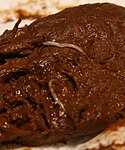Enterobius vermicularis LifeCycle B
Autor/Urheber:
Derivative work by André Koehne
Shortlink:
Quelle:
Größe:
535 x 544 Pixel (30979 Bytes)
Beschreibung:
Enterobiasis Enterobius vermicularis
Life cycle of Enterobius vermicularis
Eggs are deposited on perianal folds. Self-infection occurs by transferring infective eggs to the mouth with hands that have scratched the perianal area. Person-to-person transmission can also occur through handling of contaminated clothes or bed linens. Enterobiasis may also be acquired through surfaces in the environment that are contaminated with pinworm eggs (e.g., curtains, carpeting). Some small number of eggs may become airborne and inhaled. These would be swallowed and follow the same development as ingested eggs. Following ingestion of infective eggs, the larvae hatch in the small intestine and the adults establish themselves in the colon. The time interval from ingestion of infective eggs to oviposition by the adult females is about one month. The life span of the adults is about two months. Gravid females migrate nocturnally outside the anus and oviposit while crawling on the skin of the perianal area . The larvae contained inside the eggs develop (the eggs become infective) in 4 to 6 hours under optimal conditions. Retroinfection, or the migration of newly hatched larvae from the anal skin back into the rectum, may occur but the frequency with which this happens is unknown.
Life cycle of Enterobius vermicularis
Eggs are deposited on perianal folds. Self-infection occurs by transferring infective eggs to the mouth with hands that have scratched the perianal area. Person-to-person transmission can also occur through handling of contaminated clothes or bed linens. Enterobiasis may also be acquired through surfaces in the environment that are contaminated with pinworm eggs (e.g., curtains, carpeting). Some small number of eggs may become airborne and inhaled. These would be swallowed and follow the same development as ingested eggs. Following ingestion of infective eggs, the larvae hatch in the small intestine and the adults establish themselves in the colon. The time interval from ingestion of infective eggs to oviposition by the adult females is about one month. The life span of the adults is about two months. Gravid females migrate nocturnally outside the anus and oviposit while crawling on the skin of the perianal area . The larvae contained inside the eggs develop (the eggs become infective) in 4 to 6 hours under optimal conditions. Retroinfection, or the migration of newly hatched larvae from the anal skin back into the rectum, may occur but the frequency with which this happens is unknown.
Kommentar zur Lizenz:
Dieses Bild ist ein Werk der Centers for Disease Control and Prevention, einer dem Gesundheitsministerium der Vereinigten Staaten unterstellten Behörde, oder es wurde von einem Mitarbeiter dieser Behörde in Ausübung seiner dienstlichen Pflichten erstellt. Als ein Werk der US-amerikanischen Bundesregierung ist dieses Werk in den Vereinigten Staaten gemeinfrei.
Lizenz:
Public domain
Relevante Bilder
Relevante Artikel
MadenwurmDer Madenwurm, Springwurm, Pfriemenschwanz oder die Aftermade ist eine parasitisch in menschlichen Gedärmen lebende Fadenwurmart von bis zu 13 Millimetern Länge. Der Madenwurm ist in Europa der häufigste Eingeweidewurm beim Menschen und einer der häufigsten Parasiten des Menschen. .. weiterlesen



